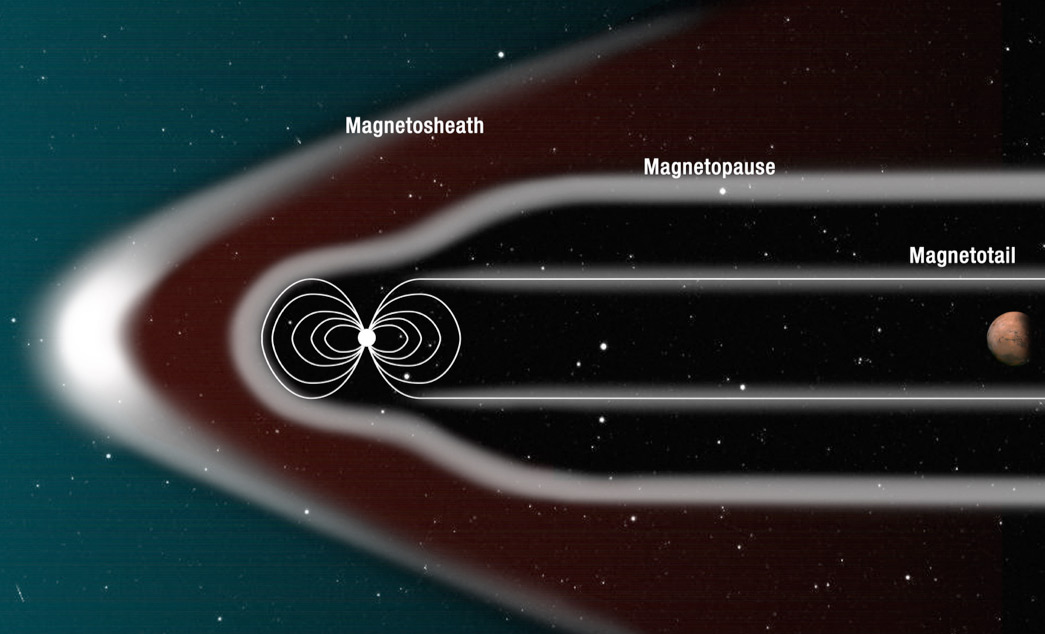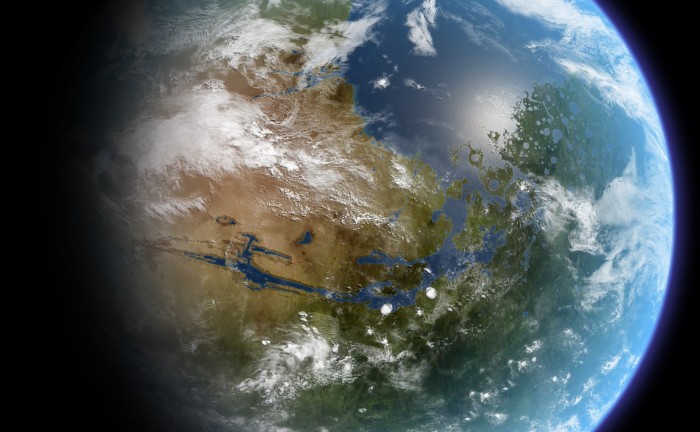Ilon Musk: local electromagnetic field generators will protect colonists on Mars

The concept of the Martian magnetic shield at the Lagrange point L1, which is located at a distance of about 320 radii of Mars. Illustration: NASA / J.Green
Ilon Musk (director of SpaceX) on his twitter suggested protecting colonists on Mars with localized electromagnetic field generators. He dropped this phrase in response to the critical remark that it is impossible to develop a settlement with people on a planet without a magnetosphere. Ilon Mask then said about the generators.
A discussion about the technical feasibility of such a decision immediately began.
Someone recalled that NASA experts had previously proposed a similar idea , but only to protect all of Mars entirely. The concept of a magnetic field generator was discussed at the Planetary Science Vision 2050 Workshop conference, which was organized by the NASA section of the Planetary Science Division in February-March 2017.
Magnetic shield
The concept involves the installation of a magnetic shield at Lagrange L1 to protect the Martian atmosphere from the solar wind and cosmic radiation.

According to scientific consensus, Mars once had a magnetic field that protected the atmosphere. About 4.2 billion years ago, the magnetic field suddenly disappeared, which caused the slow scattering of the atmosphere of Mars. Over the next 500 million years, Mars has evolved from a warm and humid environment into a cold and uninhabitable place we know today.
This theory has been confirmed by orbiters such as Mars Express from ESA and Mars Atmosphere and Volatile EvolutioN Mission (MAVEN) from NASA, which have been studying the Martian atmosphere since 2004 and 2014, respectively. They collected evidence that the solar wind is to blame for the loss of the atmosphere of Mars - and measured the speed with which the atmosphere is still lost now. Now the density of the Martian atmosphere is about 1% of the Earth's, and the loss of ions is partially compensated by volcanic activity.
It is clear that without the atmosphere, Mars will remain a cold and dry planet, and it will be difficult to develop a normal life there. In addition, the first colonists, whom they plan to send there in the 2030s, will face serious dangers. First of all, it is radiation exposure and the danger of suffocation in the absence of oxygen.
Jim Green, lead author of scientific work, director of NASA's planetary sciences, and colleagues presented an ambitious idea at the conference. In fact, they propose to arrange the magnetic dipole shield at the Lagrange point L1. It will form an artificial magnetosphere, which will cover the entire planet, protecting it from the solar wind and cosmic radiation.
Green and his colleagues admit that the idea sounds a bit "bizarre", but it is confirmed by the latest research on miniature magnetospheres (to protect spacecraft and their crews). The authors believe that in the future one can build an “inflatable structure” that will induce a magnetic dipole at the level of 1 or 2 Tesla (from 10,000 to 20,000 Gauss) as an active shield against the solar wind. For comparison, modern magnetic resonance imaging systems in hospitals on Earth induce a magnetic field of 1.5–3 Tesla, that is, such a shield is not fiction.
The location of this magnetic shield will provide shielding of two areas where the main part of the Martian atmosphere is lost: above the North Pole and in the equatorial zone with a seasonal loss of oxygen ions up to 0.1 kg / s. A series of simulations at the Coordinated Community Modeling Center (CCMC) confirmed that the idea is viable.
Shield effect
Such a shield allows you to accumulate an atmosphere with an increase in its average temperature of about 4 ° C. This is enough to melt the ice from carbon dioxide in the North polar ice cap. The consequence will be the greenhouse effect, which will further warm the atmosphere and lead to the melting of water ice in the polar caps. According to Green's calculations with colleagues, the result of the operation will be the restoration of 1/7 of the oceans of Mars - those that covered it billions of years ago.
Surprisingly, the effect of a single magnetic shield coincides with the effect of a full-fledged terraforming of Mars.

Mars after terraforming. Image: Ittiz / Wikimedia Commons
Such a transformation after the 2040s will make it possible to grow plants in the open air, place more equipment on the surface, it is easier to extract oxygen, etc. In the long run, it opens the way for full colonization of Mars. Now scientists are working on new simulations to give a more accurate estimate of how long the predicted changes will take. It also makes sense to calculate the cost of such a magnetic shield.
Perhaps it was this idea that Ilon Musk had in mind when he spoke of localized electromagnetic field generators. Or did he mean a portable magnetic field generator, which is installed directly on the surface of Mars or in orbit to protect only a local colony? The idea is the same, only less ambitious.
In addition to the generator of the magnetic field at the Lagrange point, scientists expressed another idea (see the scientific work of 2008 ): to gird the planet with superconducting cables. The illustration below shows a diagram of such a project for the Earth.

The longest cable with a length of 40,000 km and a mass of 15 million tons with liquid nitrogen cooling will generate a 7.1 Tesla magnetic field.
However, this project seems even more unusual and difficult to implement.
Feasibility
In fact, a very weak magnetic field is sufficient for protection from the solar wind, as on Earth (25–65 μT near the surface, an order of magnitude less than that of a refrigerator).
As already noted, to induce 1−2 Tesla in the area of the Martian shield is not such a big problem. But the question arises: what source of energy to use for a magnetic shield? Maybe put in the Lagrange point several satellites with nuclear generators? Again, when compared with MRI systems, the power consumption of a high-field MRI with a superconducting magnet is up to 35 kW. Probably, more fuel is needed for shunting engines so that the station with the shield maintains its exact position at point L1.
For the local generator, less induction and less power consumption will be needed, so the Ilon Mask proposal seems quite realizable.
